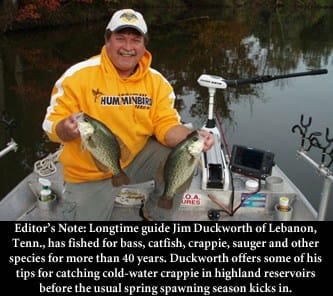As seen on theoutdoorwire.com
 When fishing for blacknose crappie in highland reservoirs, the first thing you have to do is throw the crappie rule book away because they haven’t read it.
When fishing for blacknose crappie in highland reservoirs, the first thing you have to do is throw the crappie rule book away because they haven’t read it.
Through the years and my experiences, I’ve found that in gin clear water these fish only come above 20 feet deep if it’s about to rain or snow. They love low light, but when the sun is out you have to get at least 30 feet deep. I’ve caught them as deep as 50 feet on bluebird days with the sun shining brightly in a cloudless sky.
Typically, my setup for this kind of fishing is with my signature series Float and Fly and Crappie Special rod made by B’n’M Poles. This tactic is one of the most productive for crappie, and some bass anglers use it for cold water conditions in winter when fish are feeding on small forage. I combine the rod with an Abu Garcia SX40 spinning reel spooled with 4- or 6-pound test green-tinted Trilene XL line.
Lighter line is a big plus for crappie, which in clear water can be even more finicky and selective. I’ll often use a one-eighth or one-fourth ounce Roadrunner head with either a turbo tail Roadrunner body or a 2-inch Berkley Glow Power Minnow, which really helps the fish to locate the bait. I also may use only a minnow on one of the Roadrunner glow heads when the bite is tough. Having several options is critical because crappie may want one lure one day and a minnow or combination of tactics on another.
The big secret is to find isolated cover along a 30- to 50-foot depth range. One of my biggest allies in doing this is an 1197 Humminbird Side-Imaging unit, which shows the bottom contours and any cover or structure changes. Trees are easy to find and then, I’ll drop a marker buoy just off the end of the tree. That allows me to locate the edge and cast inside the buoy over the tree.
I, then, back off about 50 feet and throw into the bank, letting the bait freefall to the tree. The key is to walk the bait through the treetop and try again if something doesn’t nab it first. This kind of fishing can be slow with the smaller jigheads, but the one-fourth ounce jighead gets down pretty quickly. That’s my main weight size. Anyone who believes crappie won’t eat a big jig or big minnow needs to try it because they can be aggressive sometimes with big baits.
When fishing this deep and on very limited cover, crappie can stack up on a tree. Because they are so hard to catch, they become monster size crappie. On average, if you catch 20 of them, you’ll often have three or four weighing more than 2 pounds and that makes it all worthwhile.
Another secret is to not fish on or near the full moon on cloudless nights because crappie will feed at night instead of during the day.
Taking the time to do some work by sinking dead trees tied off with concrete blocks can be a plus as well. But just sinking trees doesn’t automatically mean crappie will magically appear. They need to be placed in areas where crappie live or migrate, and by doing that, you’re enhancing the habitat they already live in. Additionally, check all state or federal regulations before putting anything in your lake or reservoir. For private lakes, habitat enhancements can be a big plus as well.
Once you get 20- 40 brush piles put out, you will have enough to keep you in crappie fillets for life. Remember that patience is a virtue when crappie fishing; have a variety of lures and tactics; and go have fun.
For more information about Jim Duckworth’s fishing tactics or to fish with him, visit www.jimduckworth.com.



